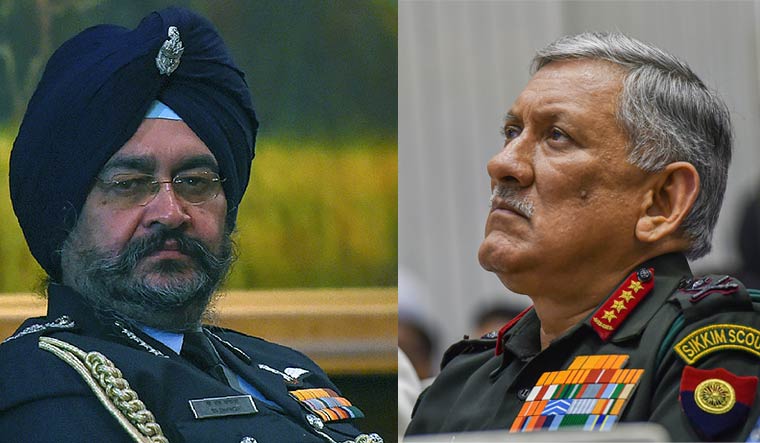With Prime Minister Narendra Modi's announcement that India will have a chief of defence staff, speculation is rife about who will be the first to hold the post.
Most bets are being placed on army chief Gen. Bipin Rawat, who is set to retire on December 31, though there are many who believe that Air Chief Marshal Dhanoa, who retires in September, could be the chosen one.
The announcement has come at the end of a long wait and longer debate which began in the 1960s, but picked up steam after the K. Subrahmanyam committee, which looked into the conduct of the Kargil war, recommended the creation of a CDS, along with integration of the service headquarters.
A group of ministers headed by the then home minister L.K. Advani examined the Subrahmanyam report and also agreed with this view. Since then, several other committees, including the Naresh Chandra committee, too had recommended the same.
The objection to the creation of a CDS had come from three fronts — political, bureaucratic and military.
The political class, since independence and particularly in the 1960s when post-colonial republics were witnessing coup after coup, had been wary of elevating the military chief to a higher status.
The bureaucracy had been concerned that the creation of a defence chief, who would be the single-point military adviser to the government, would rob them of their importance and primacy. Currently, though the defence secretary, an IAS officer, who is notionally and by protocol a notch below the three service chiefs, wields much clout as the coordinator of defence policies.
Within the military, the IAF had always opposed the creation of a defence chief on the ground that it would give primacy to the army, as one witnessed during the 1971 war.
Following the Subrahmanyam committee and the Advani reports, the three service headquarters had been integrated, and a chief of integrated staff (who holds the rank of a lieutenant-general) had also been created. But the services continued to train, plan and operate separately. Now the creation of a CDS is expected to bring about more integration, especially in procurement, training and planning of operations.
However, there is still no clarity whether the CDS would be a five-star officer — field marshal, admiral of the fleet or marshal of the air force. These ranks have been given in India only as honorary, and not operational. Most likely, as most committees have recommended, he would be another four-star officer (general, admiral or air chief marshal).
Similarly, unlike what is commonly thought, the CDS is not likely to have any operational authority over the three chiefs. He will be only chief of the entire defence staff. The current chiefs will most likely continue to be the operational chiefs. Currently, the service chiefs wore two hats — one as operational commander and one as chief of staff.
In several countries, including the US and neighbouring Pakistan, the chief of defence staff (chairman, joint chiefs of staff in the USA) is an officer who holds the same rank as the three service chiefs. In Pakistan, the joint chief is even a notch below the army chief who wields real power.
In India, the CDS's relationship with the three chiefs would just be similar to the relationship between the chief justice and the other judges in the supreme court. He would have no authority over operational matters. He would be convening the chiefs of staff committee, chairing its meetings, coordinating the planning and requirements of the three services, prioritising procurement requirements, and giving coordinated and composite military advice to the government.



